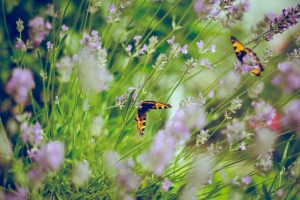At Glover Nursery, hydrangeas are one of our favorite summertime plants. With their big, colorful blooms brightening up the garden, it’s easy to see why.
However, proper hydrangea fall care is something many customers struggle with, which is why we created this guide that you can use as a “checklist” when fall comes around.
Identifying your Hydrangea variety
The first step in caring for hydrangeas in Utah is knowing which type you’re growing. Correct identification saves time and effort while ensuring you set realistic expectations for blooms.
Hydrangeas bloom either on old wood or new wood, and that affects how you prune. Panicle hydrangeas and smooth hydrangeas bloom on new wood, which makes them more resilient to pruning and a good choice for Utah’s climate.
Old wood bloomers like bigleaf (Macrophylla) and oakleaf (Quercifolia) hydrangeas need to be pruned at specific times of year, before the buds have set for next season’s bloom cycle. Pruning this too late in the year will cut off next year’s flowers, and you won’t see those amazing blossoms until the following year.
Repeat-blooming hydrangeas, such as Endless Summer, bloom on both old and new wood. As such, they can handle accidental pruning of new buds if done at the wrong time of year, but for optimal blooms in a Utah spring, you will want to follow the same protocol as the Bigleaf and Oakleaf varieties.
When choosing a Hydrangea for your garden, the factors to consider are soil type, water type, and the hours of sun the plant will receive. Panicle varieties can better handle the denser clay soil, can tolerate some alkalinity in the water, and can also handle more hours of direct sunlight.
Macrophylla will not do well in those same conditions, but will do better in loamy or sandier areas of Northern Utah. For example, neighborhoods that are higher up on the benches of the Salt Lake Valley showcase beautiful bigleaf hydrangeas that are thriving. Though they do not like hot afternoon sun, so be sure to place them in an area that is shaded after 2-3 pm.
Deadheading Hydrangeas in Utah
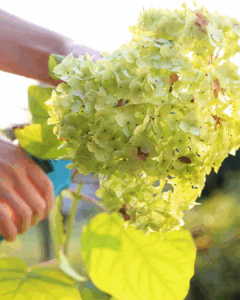
Although not a requirement for our hydrangea fall care “checklist”, it does help keep them neat through the season. For new wood bloomers, you can remove spent flowers anytime without hurting future blooms.
Old wood bloomers should keep their dried flowers after mid-August, because those heads protect the next year’s buds from wind and cold. Leaving them in place is especially helpful during Utah’s dry, fluctuating fall weather.
Many gardeners also enjoy the look of dried flower clusters in snowy landscapes. Hydrangeas with their papery heads add a “winter beauty” when snow collects on them.
If you choose to keep them, do not prune the plant until after they flower again in the spring. Pruning them after August ensures you will be cutting off the buds that will be blooming next year.
Pruning Hydrangeas in Utah
Pruning hydrangeas requires careful timing, regardless of where you live, and Utah is no exception. Old wood bloomers should not be pruned in the fall, since their buds have already formed.
Cutting them now means losing next year’s flowers entirely. Instead, shape or thin them only in midsummer after flowering.
New wood bloomers are more flexible and can be pruned in fall, late winter, or early spring. That being said, wait until the plant is fully dormant for winter, as pruning too early can encourage new growth that the frost will damage.
It’s best to wait until the coldest part of winter has passed before cutting Panicle varieties. This gives your shrubs the best chance of producing healthy, strong growth the following spring.
For our hydrangea fall care, start your pruning by removing weak, broken, or dead stems. After that, trim back no more than 1/3 of the shrub’s size.
This approach maintains your hydrangea’s vigor and allows enough energy for strong flowering the following summer. Over-pruning weakens hydrangeas, leaving them vulnerable in an already challenging climate.
If you have the following species in your garden, see our detailed Hydrangea pruning guide to get a step-by-step plan tailored to each variety’s growth and flowering cycle:
- Paniculata
- Arborescens
- Macrophylla
- Quericifolia
- Climbing
Fertilizing hydrangeas in Utah
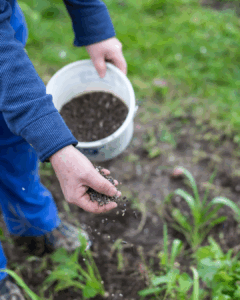 Fertilizer timing matters more in Utah than in milder regions. The state’s high alkaline soils already stress hydrangeas, and overfeeding with the wrong nutrients can worsen the problem.
Fertilizer timing matters more in Utah than in milder regions. The state’s high alkaline soils already stress hydrangeas, and overfeeding with the wrong nutrients can worsen the problem.
Established hydrangeas only need one application of slow-release fertilizer in the spring. Anything more risks salt buildup in dry soils, which leads to scorched leaves.
Many gardeners would love to have blue hydrangeas, but the soil pH in Utah makes that very difficult. Only Macrophylla/Bigleaf varieties can shift color based on soil acidity. Adding sulfur or other acidifying fertilizers can lower pH temporarily, but Utah’s alkaline soils usually revert over time.
Because of this, acidifying treatments must be replenished every year to keep blossoms blue. In most Utah gardens, pink flowers are far more common, while attempts at blue blooms often result in pastel purples or pinks instead.
Note: For reliable performance, focus on soil health and moisture rather than chasing bloom color.
Adding compost each fall is one of the best practices for Utah hydrangea care. Compost improves soil structure, retains moisture, and adds nutrients as it breaks down over winter. This organic method also helps to keep more moisture in the soil throughout the year, which benefits all varieties of hydrangea here in Utah’s dry climate.
Mulching Hydrangeas for Utah Winters
Mulching is one of the most important steps for hydrangea fall care. Harsh winters and dry summers make root protection essential.
Mulch not only protects roots from freezing, but it also helps retain precious soil moisture. A good mulch layer evens out soil temperature and reduces stress. Without it, hydrangeas risk both winter injury and summer drought stress.
Here at Glover Nursery, we apply 2-4 inches of shredded bark, compost, or pine needles around the base of each shrub in late fall. Always apply mulch in a donut shape around the base of the plant/root flare, leaving a few inches clear around the crown. Avoid piling mulch directly against stems to prevent rot, infestation, and fungal diseases
Winterizing Hydrangeas
Hydrangeas are hardy shrubs. However, their greatest threats are Utah’s cold winds and freeze-thaw cycles.
Old wood bloomers are especially at risk because their buds form the year before. Protecting them requires careful site selection and sometimes physical barriers.
For our hydrangea fall care practices, we highly recommend planting them in slightly sheltered planting sites near buildings, fences, or evergreen windbreaks. These structures reduce cold wind exposure, which improves survival through our cold, dry winters.
Planting where hydrangeas receive morning sun and afternoon shade also helps them tolerate Utah’s hot summers.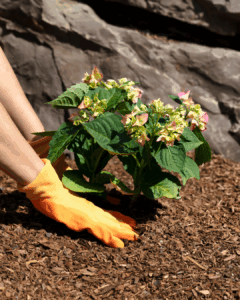
You can also wrap shrubs in burlap since it can shield buds and prevent winter desiccation from dry air. Never, ever cover your plants with plastic, since it traps moisture and damages the stems. Covering your plants in plastic will create conditions where they will rot and die. Burlap allows air circulation while blocking harsh winds.
Remove coverings gradually in the early spring as temperatures stabilize. Sudden exposure can shock shrubs after months of insulation, so it’s important to time your removal to avoid injuring your hydrangeas.
And, be sure to give your hydrangea some water during the course of winter. We do not receive enough precipitation here in Utah to saturate the soil, and though the plant is dormant above ground, the roots do still need regular access to water to keep the plant alive over the winter.
An easy way to remember when to water: Every holiday beginning around Halloween in October through President’s Day in February, give them a good, deep soaking. For suggestions on how to make this chore as easy as possible, check out our watering recommendations here.
Deer prevention for Hydrangeas
Last in our hydrangea fall care is preventing deer damage. Deer are a serious concern for many Utah gardeners, especially near foothills and canyons. Hydrangeas are highly attractive to deer, and entire shrubs can be stripped overnight. Protecting them from deer is often as important as weatherproofing.
Strong-scented plants like lavender, rosemary, and boxwood deter deer when planted near hydrangeas. Combining these repellents with companion planting can deter deer better than anything else, especially during winter, when food sources are scarce.
If you’d like to learn additional methods to safeguard your plants from them, our deer damage prevention blog covers all the tips you need.
FAQs
What Causes Black Spots on the Leaves?
Black spots on hydrangea leaves are usually caused by a fungal problem called leaf spot. While this disease is more common in humid climates, it can still appear in Utah.
Here, it often develops in spring during stretches of cool, wet weather or when irrigation practices keep foliage damp for too long. Overhead sprinklers and frequent lawn watering that splash water onto leaves give fungal spores the conditions they need to spread.
To reduce the chance of leaf spot, water hydrangeas at the base instead of overhead, and maintain good airflow around plants. If the problem repeats each year, applying an organic fungicide early in the season can provide extra protection.
Fortunately, this condition is mostly cosmetic and does not usually kill the shrub. Even if some leaves yellow and fall early, healthy new ones will return the following season once watering and care are managed properly.
If you think another issue is affecting your hydrangea, Glover Nursery is here to help. Send us a photo of your plant through our Plant Diagnosis page, and the Glover Nursery Diagnostic Team will be on your case. Results might take up to 3 business days.
What to Do With Leaves That Have Turned Dark and Wrinkled?
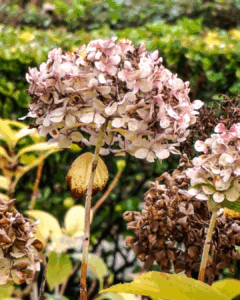 In Utah, hydrangea leaves often turn dark and wrinkled once frost arrives in fall, sometimes as early as late September in colder valleys.
In Utah, hydrangea leaves often turn dark and wrinkled once frost arrives in fall, sometimes as early as late September in colder valleys.
It’s best to leave these “leaves” on the plant because they provide a light layer of insulation for developing buds. As winter progresses, the leaves will naturally drop without harming the shrub.
Allowing these leaves to remain in place supports the plant’s transition into dormancy. Yes, they do help protect the buds.
However, as a good rule of thumb in hydrangea care, we add other measures like mulching around the base or wrapping it with burlap. This helps protect it even more, especially in exposed locations.
By spring, the damaged leaves will be gone, and healthy new growth will replace them.
